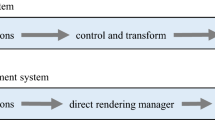Abstract
This paper designs and implements a cloud rendering system. The system supports application of server cluster load balancing, static extension of rendering machine, and design architecture of parallel task scheduling. At the same time, we put forward a new design idea, and we implement a set of communication rules of multi-task renderer and cloud rendering system. On the system, users could browse 3D scene online by mobile terminal equipments. The task of PC terminal users and mobile terminal users to access remote scenes could be high speed and real-time rendering by this system. In the end of this paper, we analyze the efficiency of our algorithm. Our system can achieve a better effect on the number of concurrent users and the average response delay. The average frame rate of system can reach 30–40 frames per second. Experimental results show that the proposed algorithm performs favorably against the state-of-the-art methods on the public test datasets.


























Similar content being viewed by others
References
Aldrian O, Smith WAP (2012) Inverse Rendering of Faces on a Cloudy Day. Computer Vision – ECCV 2012. Springer Berlin Heidelberg, pp. 201–214
Cheung G, Velisavljevic V, Ortega A (2011) On Dependent Bit Allocation for Multiview Image Coding With Depth-Image-Based Rendering. IEEE Transactions on Image Processing A Publication of the IEEE Signal Processing Society 20(11):3179–3194
Cho HW, Chung SW, Song MK et al (2011) Depth-image-based 3D rendering with edge dependent preprocessing. Midwest Symposium on Circuits & Systems 47(10):1–4
Chow SK, Chan KL (2011) Fast and Realistic Rendering of Deformable Virtual Characters Using Impostor and Stencil Buffer. International Journal of Image & Graphics 06(4):599–624
Huang H, Fu TN, Li CF (2011) Painterly rendering with content-dependent natural paint strokes. Vis Comput 27(9):861–871
Huang TS, Zhang C (2015) A layered method of visibility resolving in depth image-based rendering. International Conference on Pattern Recognition. DBLP, pp. 1–4
Ishii M, Takahashi K, Naemura T (2010) Joint Rendering and Segmentation of Free-Viewpoint Video. Journal on Image & Video Processing 2010(1):3
Liu Y, Huang Q, Ma S et al (2011) A novel rate control technique for multiview video plus depth based 3D video coding. IEEE Trans Broadcast 57(2):562–571
Ndjiki-Nya P, Koppel M, Doshkov D et al (2011) Depth image-based rendering with advanced texture synthesis for 3-D video. IEEE Transactions on Multimedia 13(3):453–465
Ning X, Laga H, Saito S et al (2011) Contour-driven Sumi-e rendering of real photos. Comput Graph 35(1):122–134
Pajak D, Herzog R, Eisemann E et al (2011) Scalable Remote Rendering with Depth and Motion-flow Augmented Streaming. Proceedings of the 32th annual conference of the European Association for Computer Graphics (EG 04) 30(2):415–424
Shi S, Nahrstedt K, Campbell R (2012) A real-time remote rendering system for interactive mobile graphics. ACM Transactions on Multimedia Computing, Communications, and Applications (TOMCCAP) 8(3s):46
Solh M, Alregib G (2010) Hierarchical Hole-Filling (HHF): Depth image based rendering without depth map filtering for 3D-TV. IEEE International Workshop on Multimedia Signal Processing. IEEE Xplore, pp. 87–92
Süß T, Koch C, Jähn C, et al (2011) Approximative occlusion culling using the hull tree. Proceedings of Graphics Interface 79–86, St. John's, Newfoundland
Wang R, Chen Y, Ma S, Lv J (2016) A Robust and Real-time Object Tracking Method in Frequency Domain Space. Journal of Beijing University of Aeronautics and Astronautics. https://doi.org/10.13700/j.bh.1001-5965.2016.0906
Wang S, Dey S (2012) Cloud mobile gaming: modeling and measuring user experience in mobile wireless networks. ACM SIGMOBILE Mobile Computing and Communications Review 16(1):10–21
Wang S, Dey S (2013) Adaptive Mobile Cloud Computing to Enable Rich Mobile Multimedia Applications. IEEE Transactions on Multimedia 15(4):870–833
Wang R, Lv J, Ma S (2017) A MRI image segmentation method based on medical semaphore calculating in medical multimedia big data environment. Multimed Tools Appl. https://doi.org/10.1007/s11042-017-4591-3
Wu W, Arefin A, Kurillo G et al (2012) CZLoD: A psychophysical approach for 3D tele-immersive video. ACM Transactions on Multimedia Computing, Communications, and Applications (TOMCCAP) 8(3s):39
Xi M, Wang LH, Yang QQ et al (2013) Depth-image-based rendering with spatial and temporal texture synthesis for 3DTV. Eurasip Journal on Image & Video Processing 2013(1):9
Zang Y, Huang H, Li CF (2014) Artistic preprocessing for painterly rendering and image stylization. Vis Comput 30(9):969–979
Zeng K, Zhao M, Xiong C et al (2013) From image parsing to painterly rendering. ACM Trans Graph 29(1):1–11
Acknowledgments
We sincerely thanks the reviewers and editors’ work to this paper.
Funding
We sincerely thank each one of the reviewer and editors’ work to the paper. This paper is supported by National Natural Science Foundation Projects of China (Grant No. 61300007). The National Key Research and Development Program of China: Research and development of intelligent security card port monitoring and warning platform (Grant No. 2016YFC0800507), Innovation Foundation Program of China Electronics Technology Group Corporation: Research on holographic and abnormal behavior intelligent warning technology for social security risk targets.
Author information
Authors and Affiliations
Contributions
Authors have contributed equally to the manuscript while Ronghe Wang have implemented the texture descriptors and performed most of the tests. All authors read and approved the final manuscript.
Corresponding author
Ethics declarations
Competing interests
The authors do not have any competing interests.
Additional information
Publisher’s Note
Springer Nature remains neutral with regard to jurisdictional claims in published maps and institutional affiliations.
Rights and permissions
About this article
Cite this article
Wang, R., Zhang, B., Bi, J. et al. Cloud rendering learning platform technology research for visual analysis of large scale 3D multimedia data. Multimed Tools Appl 79, 5371–5398 (2020). https://doi.org/10.1007/s11042-018-6569-1
Received:
Revised:
Accepted:
Published:
Issue Date:
DOI: https://doi.org/10.1007/s11042-018-6569-1




